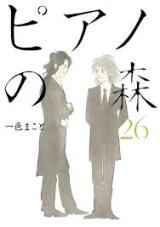
User rating of this review - 4.67 out of 5
Story/Plot - 4.5 out of 5
Characters - 4.5 out of 5
Drawing Style - 3.5 out of 5
Enjoyment - 5 out of 5
Overall - 5 out of 5
Synopsis
In a quiet, idyllic town that houses the Moriwaki Elementary, the chance arrival of a transfer student brings together the three main characters of a piano-based epic. Ichinose Kai is the bastard child of a prostitute that uses an abandoned old piano as an escape from his harsh life in the underworld community of the "Forest Edge." Amamiya Syuhei is the son of a world famous pianist, pressured into studying the piano and following in his father's footsteps at an early age largely against his own will. Ajino Sousuke is a former world famous pianist whose passion and calling in life were all destroyed in a single unfortunate accident.
Review
Together these three characters kindle a passion for the piano in each other and set off on a journey towards the very pinnacle of the international piano society. Ichinose's passion is one of fulfillment and expression. It is in his nature to reach out to his maximum potential so that he may most effectively share the "Piano of the Forest," the oasis of his childhood, with all that would listen. Amamiya's drive is one of competition, a dark, grueling, obsessive, competitive drive against Kai that borders on an inferiority complex. Ajino's path is one of rebirth and resurrection. He finally casts off the shackles of his loss and finds a second lease on life in nurturing a bright star of a new generation.
Their story, journey, and passion comes alive through the series of realistic challenges that they face and through much interaction with the colorful supporting cast of characters. The author often drops subtle hints throughout the series for character development, comedic effect, and plot advancement. It's a wonderful feeling when the story rhythmically build up suspense and tension and releases it in a logical, satisfying, and entertaining fashion. Nothing should come as a total surprise to the readers, and I imagine a few will kick themselves for not picking up on the many clever instances of foreshadowing.
There are moments of weakness where mood or facial expressions fail to convey the required effect. For example, Ajino's supposedly scary disposition at the beginning of the series wasn't all that scary. Most of this is because the adult facial proportions isn't great and the depiction of negative emotions cannot stand on their own. The series does suffer on various occasions but usually avoids this fault by mostly depicting children and youths with sunnier disposition and supplements the art with strong narrative passages.
(Review, in consideration of content through chapter 72 in volume 9.)
With 17 volumes already compiled in book form, dozens of chapters published in issues of Morning magazine, and more chapters to be expected from the ongoing series, readers of the series will have a long series to enjoy and wait in anticipation for new chapters as the story heads towards its conclusion. The pacing the story has a few changes due to publishing anomalies.





